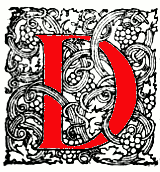In transcribing the following paragraphs from the Internet Archive online version of The Imperial Gazetteer’s entry on Egypt I have divided the long entry into separate documents, expanded abbreviations for easier reading, and added paragraphing and links to material in the Victorian Web. The lithograph of Robert’s watercolor is not in the Gazetteer. — George P. Landow

View from under the Portico of the Temple of Dendera. Lithograph by Louis Haghe after a drawing by David Roberts, RA (1796-1864) from Egypt and Nubia (1842). Click on image to enlarge it.

enderah [the Tentyra of the Greeks and Romans] is a ruined town of Upper Egypt situated on the left bank of the Nile at latitude 26˚ 10' 7" North and longitude 32˚ 40' 7" East. It is celebrated for its temple, the most magnificent, and best preserved, of any of the remains of antiquity in Egypt. The town stands on a plain, surrounded by mountains, and beautified by palm trees. About the distance of 1 ½ miles East are the ruins of the temple of Isis. They are nearly all enclosed within a square wall, built of sun dried bricks. This wall is, on either side, 1000 feet in length, in some parts 35 feet high, and 15 feet thick. The gateway which leads to the temple is a singularly beautiful specimen of Egyptian architecture and sculpture; it is 42 feet in height, 33 feet in width, and 17 feet in depth, and is covered with hieroglyphs and ornaments, elegantly designed and exquisitely cut. The portico of the temple consists of 24 columns, in three rows; each above 22 feet in circumference, 32 feet high, and covered with hieroglyphs.


Two of Francis Frith’s photographs from Egypt and Palestine (1858). Left: Dendera. Right: Sculptures from the Outer Wall, Dendera. [Click on images to enlarge them.]
The interior consists of several apartments, all the walls and ceilings of which are covered with religious and astronomical representations, including (be figure of Isis, the presiding deity of the place, which is very frequently repeated. The roofs are flat, and are formed of oblong masses of stone resting on the side walls, or on rows of columns carried down the middle of the apartment, and whose capitals are richly ornamented with the budding lotus, The only light admitted to the interior was by small perpendicular holes cut in the ceiling, or by oblique apertures in the sides. It was thus exceedingly dark and gloomy, but well calculated for the mysterious religious rites of which it was the scene.
The most remarkable object, however, belonging to the temple, and that which has excited the greatest interest, is a mythological table, resembling a celestial planisphere or zodiac, sculptured on a kind of sandstone, and forming the ceiling of one of the upper chambers. It occupied the central space of three concentric circles, and appeared as if supported by 12 figures, four of which are females. These are standing, while the eight male figures, who have hawks heads, are represented kneeling. The zodiac, as it is called, was care fully removed from its original place in 1822, and conveyed to France, and is now in the museum at Paris. It has formed a fertile source of discussion among antiquaries, great differences of opinion existing as to what it is, and how old it is. [821-22]
Related material
- The Zodiac at Dendera and the debate over the age of the earth
- Map the Temple of Hathor, Dendera, from Macmillian & Co.’s Guide to Palestine and Egypt (1901)
Bibliography
Blackie, Walker Graham. The Imperial Gazetteer: A General Dictionary of Geography, Physical, Political, Statistical and Descriptive. 4 vols. London: Blackie & Son, 1856. Internet Archive. Inline version of a copy in the University of California Library. Web. 31 July 2020.
Buchwald, Jed Z. and Diane Greco Josefowicz, The Zodiac of Paris: How an Improbable Discovery over an Ancient Egyptian Artifact Provoked a Modern Debate between Science and Religion. Princeton: Princeton University Press, 2010.
Last modified 3 August 2020